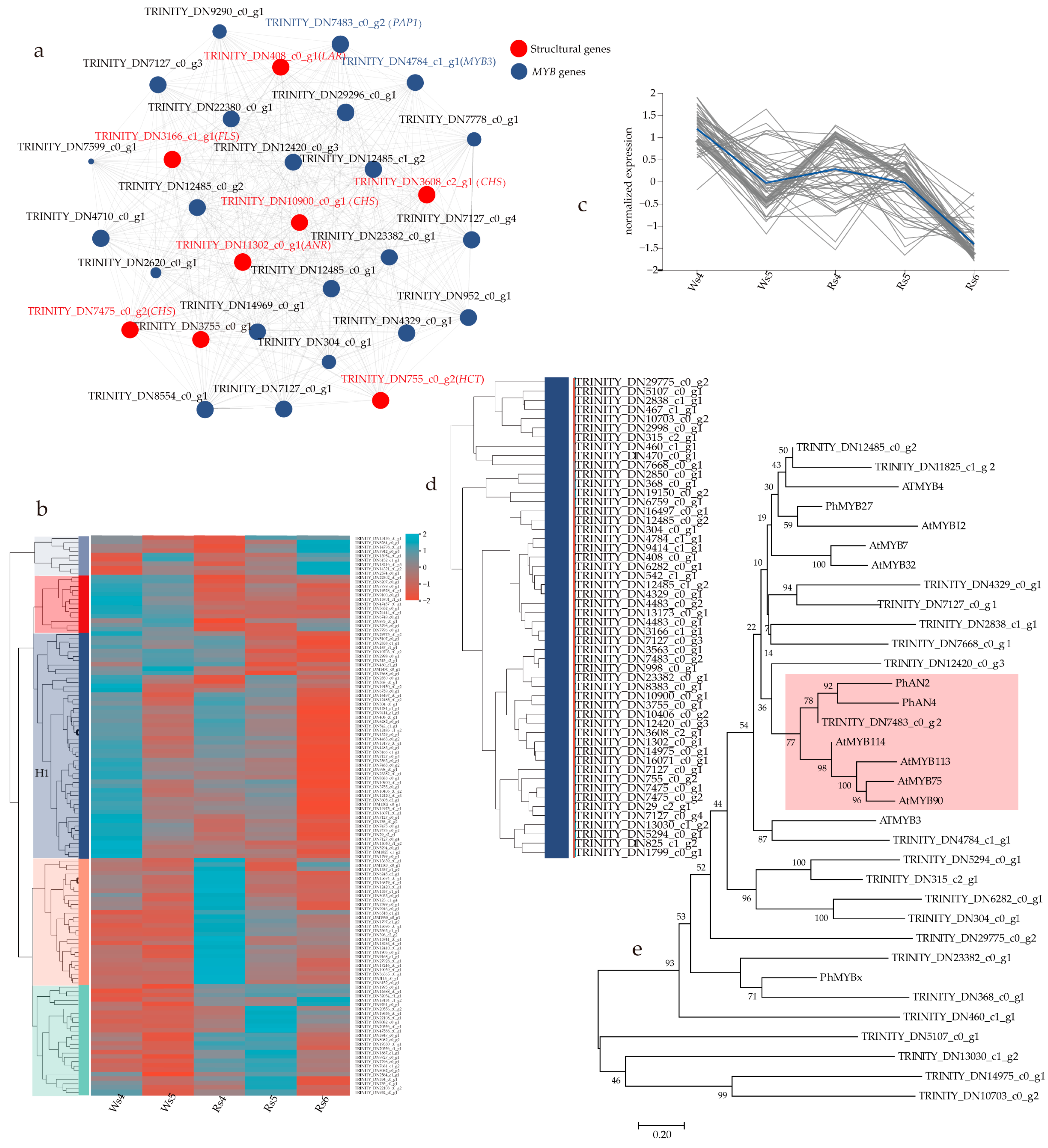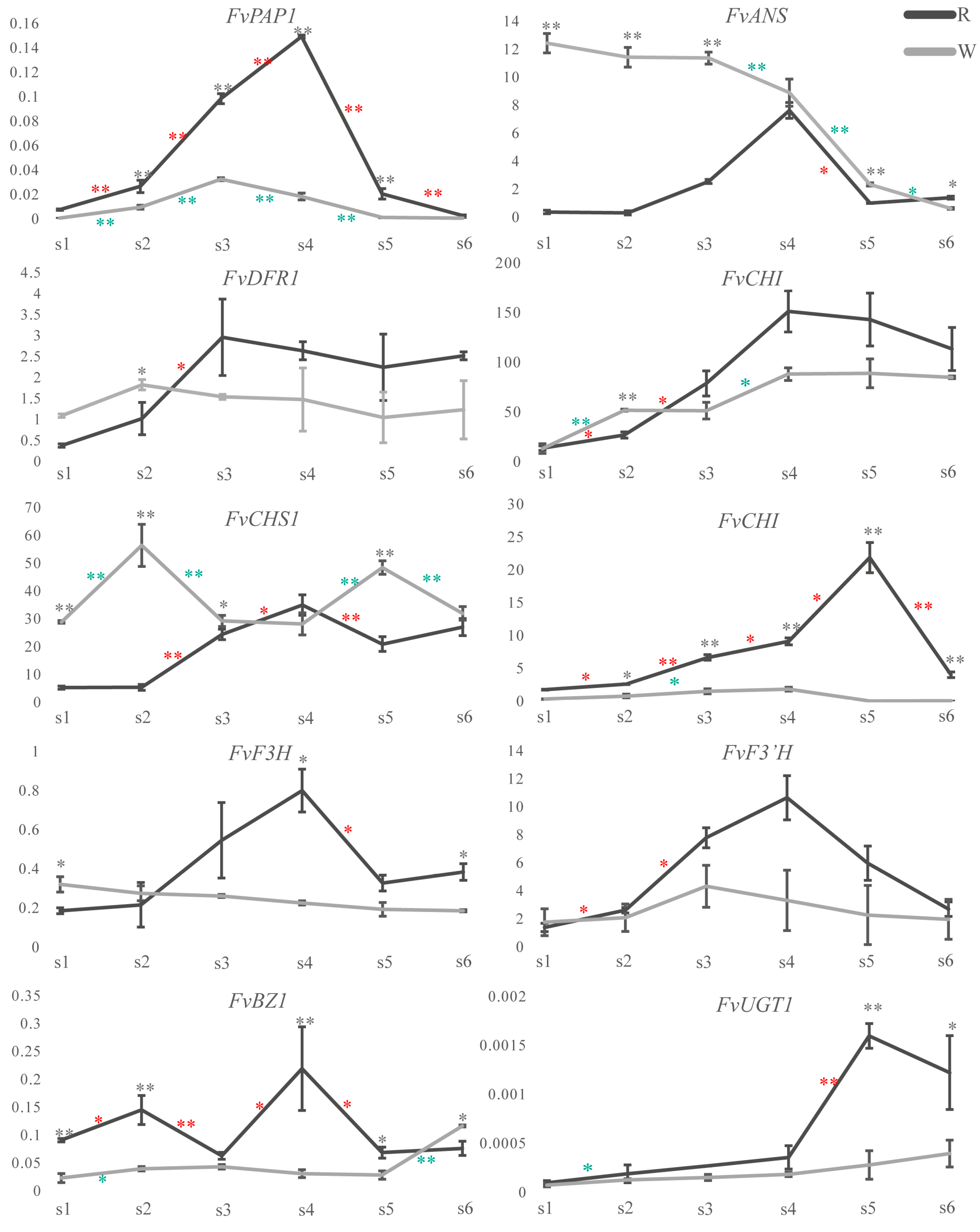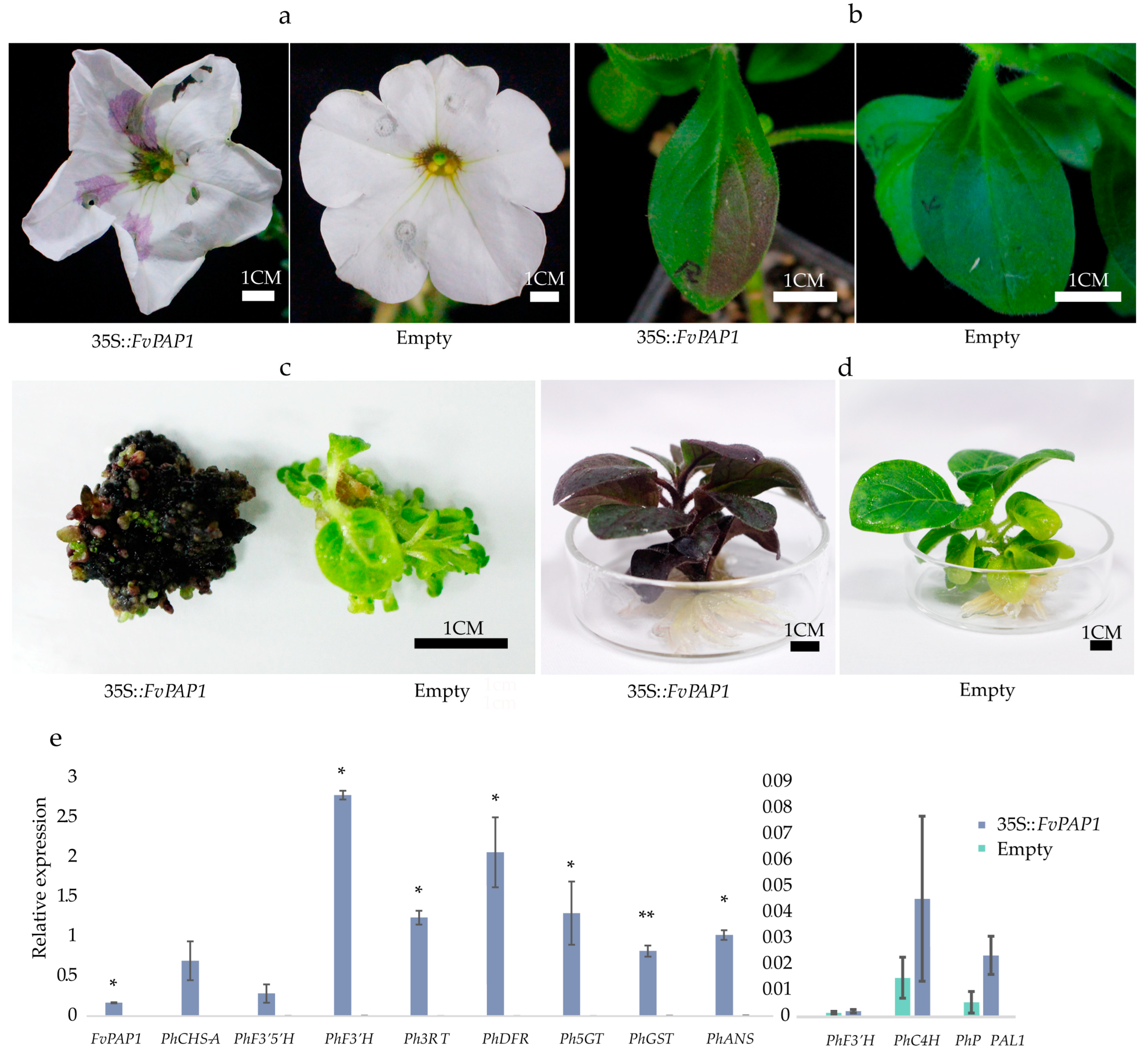Transcriptome Analysis Reveals That FvPAP1 Genes Are Related to the Prolongation of Red-Leaf Period in Ficus virens
Abstract
:1. Introduction
2. Materials and Methods
2.1. Plant Materials
2.2. Quantitative Analysis of Anthocyanins
2.3. Quantitative Analysis of Chlorophyll
2.4. Transcriptomic Analysis
2.5. Identification of the Structural Genes of the Anthocyanin Pathway
2.6. Phylogenetic Analysis for the MYB Genes
2.7. Primer Design
2.8. Cloning of the Transcript Sequences Related to Anthocyanin Biosynthesis
2.9. qRT-PCR
2.10. Construction of the FvPAP1 Expression Vector
2.11. Transient Expression
2.12. Genetic Transformation of Nicotiana Tabacum
3. Results
3.1. Morphological Characteristics of Ficus virens during Leaf Development
3.2. Comprehensive Transcriptomic Analysis
3.3. Identification of the Structural Genes Related to Anthocyanin Biosynthesis and the MYB Genes
3.4. Cloning of the Transcript Sequences Related to Anthocyanin Biosynthesis
3.5. Analysis of the Expression of the Anthocyanin Biosynthetic and Regulatory Genes
3.6. Functional Verification of FvPAP1
4. Discussion
5. Conclusions
Supplementary Materials
Author Contributions
Funding
Data Availability Statement
Conflicts of Interest
References
- Corner, E.J.H. Ficus (Moraceae) and Hymenoptera (Chalcidoidea): Figs and their pollinators. Biol. J. Linn. Soc. 1985, 25, 187–195. [Google Scholar] [CrossRef]
- Iqbal, D.; Khan, M.S.; Khan, M.S.; Ahmad, S.; Hussain, M.S.; Ali, M. Bioactivity guided fractionation and hypolipidemic property of a novel HMG-CoA reductase inhibitor from Ficus virens Ait. Lipids Health Dis. 2015, 14, 15. [Google Scholar] [CrossRef] [PubMed]
- Iqbal, D.; Khan, M.S.; Khan, M.S.; Ahmad, S.; Srivastava, A.K. An in vitro and molecular informatics study to evaluate the antioxidative and β-hydroxy-β-methylglutaryl-CoA reductase inhibitory property of Ficus virens Ait. Phytother. Res. 2014, 28, 899–908. [Google Scholar] [CrossRef] [PubMed]
- Hafeez, A.; Jain, U.; Sajwan, P.; Srivastava, S.; Thakur, A. Evaluation of Carrageenan induced anti-inflammatory activity of ethanolic extract of bark of Ficus virens Linn. in swiss albino mice. J. Phytopharm. 2013, 2, 39–43. [Google Scholar] [CrossRef]
- Lee, S.H.; Ng, A.B.; Lim, R.C.; Francisco, R.; Ng, W.Q.; Ng, X.Y.; Neo, L.; Yee, A.T.; Chong, K.Y.; Tan, H.T. Status and distribution in Singapore of Ficus virens Aiton (Moraceae). Nat. Singap. 2013, 6, 223–227. [Google Scholar]
- Patel, M.H.; Desai, B.; Jha, S.; Patel, D.; Mehta, A.; Garde, Y. Phytochemical, pharmacognosy and ethnobotanical importance of the Ficus virens Aiton. Pharma Innov. J. 2023, 12, 4017–4021. [Google Scholar]
- Rai, S.; Sabesan, G.S.; Babu, K. Comparative pharmacognostic studies on the barks of four Ficus species. Turk. J. Bot. 2010, 34, 215–224. [Google Scholar] [CrossRef]
- Chaudhary, I.J.; Rathore, D. Phytomonitoring of dust load and its effect on foliar micromorphological characteristics of urban trees. Plantica J. Plant Sci. 2018, 2, 170–179. [Google Scholar]
- Liu, L.; Guan, D.; Peart, M.R.; Wang, G.; Zhang, H.; Li, Z. The dust retention capacities of urban vegetation-a case study of Guangzhou, South China. Environ. Sci. Pollut. Res. Int. 2013, 20, 6601–6610. [Google Scholar] [CrossRef]
- Soejono, S.; Budiharta, S.; Arisoesilaningsih, E. Proposing local trees diversity for rehabilitation of degraded lowland areas surrounding springs. Biodiversitas J. Biol. Divers. 2013, 14, 37–42. [Google Scholar] [CrossRef]
- Zhang, X.; Zeng, B.; Zhong, Z. Differential responsiveness in stem height and diameter growth of two Ficus tree species in the Three Gorges reservoir region of China as affected by branch removal. Can. J. For. Res. 2007, 37, 1748–1754. [Google Scholar] [CrossRef]
- Wang, Z.; Jiang, X.; Jiang, H.; Yang, L.; Zhou, F.; Lu, C. Application of major tree species for the CAST stereoscopic landscape demonstration project. J. Landsc. Res. 2012, 4, 65–71. [Google Scholar]
- Dominy, N.J.; Lucas, P.W.; Ramsden, L.W.; Riba-Hernandez, P.; Stoner, K.E.; Turner, I.M. Why are young leaves red? Oikos 2002, 98, 163–176. [Google Scholar] [CrossRef]
- Manetas, Y. Why some leaves are anthocyanic and why most anthocyanic leaves are red? Flora-Morphol. Distrib. Funct. Ecol. Plants 2006, 201, 163–177. [Google Scholar] [CrossRef]
- Zheng, X.; Niklas, K.J.; Ratkowsky, D.A.; Jiao, Y.; Ding, H.; Shi, P. Comparison of Leaf Shape between a Photinia Hybrid and One of Its Parents. Plants 2022, 11, 2370. [Google Scholar] [CrossRef]
- Liu, W.; Nisar, M.F.; Wan, C. Characterization of Phenolic Constituents from Prunus cerasifera Ldb Leaves. J. Chem. 2020, 2020, 1–5. [Google Scholar] [CrossRef]
- Chen, X.; Liu, H.; Wang, S.; Zhang, C.; Liu, L.; Yang, M.; Zhang, J. Combined transcriptome and proteome analysis provides insights into anthocyanin accumulation in the leaves of red-leaved poplars. Plant Mol. Biol. 2021, 106, 491–503. [Google Scholar] [CrossRef] [PubMed]
- Mehlenbacher, S.A.; Smith, D.C. ‘Red Dragon’ornamental hazelnut. HortScience 2009, 44, 843–844. [Google Scholar] [CrossRef]
- Wadl, P.A.; Wang, X.; Pantalone, V.R.; Trigiano, R.N. Inheritance of red foliage in flowering dogwood (Cornus florida L.). Euphytica 2010, 176, 99–104. [Google Scholar] [CrossRef]
- Holton, T.A.; Cornish, E.C. Genetics and biochemistry of anthocyanin biosynthesis. Plant Cell 1995, 7, 1071. [Google Scholar] [CrossRef]
- Liu, Y.; Tikunov, Y.; Schouten, R.E.; Marcelis, L.F.; Visser, R.G.; Bovy, A. Anthocyanin biosynthesis and degradation mechanisms in Solanaceous vegetables: A review. Front. Chem. 2018, 6, 52. [Google Scholar] [CrossRef] [PubMed]
- Stracke, R.; Werber, M.; Weisshaar, B. The R2R3-MYB gene family in Arabidopsis thaliana. Curr. Opin. Plant Biol. 2001, 4, 447–456. [Google Scholar] [CrossRef] [PubMed]
- Gonzalez, A.; Zhao, M.; Leavitt, J.M.; Lloyd, A.M. Regulation of the anthocyanin biosynthetic pathway by the TTG1/bHLH/Myb transcriptional complex in Arabidopsis seedlings. Plant J. 2008, 53, 814–827. [Google Scholar] [CrossRef] [PubMed]
- Li, G.; Serek, M.; Gehl, C. Physiological changes besides the enhancement of pigmentation in Petunia hybrida caused by overexpression of PhAN2, an R2R3-MYB transcription factor. Plant Cell Rep. 2023, 42, 609–627. [Google Scholar] [CrossRef]
- Zhang, B.; Xu, X.; Huang, R.; Yang, S.; Li, M.; Guo, Y. CRISPR/Cas9-mediated targeted mutation reveals a role for AN4 rather than DPL in regulating venation formation in the corolla tube of Petunia hybrida. Hortic. Res. 2021, 8, 116. [Google Scholar] [CrossRef] [PubMed]
- Koes, R.; Verweij, W.; Quattrocchio, F. Flavonoids: A colorful model for the regulation and evolution of biochemical pathways. Trends Plant Sci. 2005, 10, 236–242. [Google Scholar] [CrossRef]
- Albert, N.W.; Davies, K.M.; Lewis, D.H.; Zhang, H.; Montefiori, M.; Brendolise, C.; Boase, M.R.; Ngo, H.; Jameson, P.E.; Schwinn, K.E. A conserved network of transcriptional activators and repressors regulates anthocyanin pigmentation in eudicots. Plant Cell 2014, 26, 962–980. [Google Scholar] [CrossRef] [PubMed]
- Dubos, C.; Stracke, R.; Grotewold, E.; Weisshaar, B.; Martin, C.; Lepiniec, L. MYB transcription factors in Arabidopsis. Trends Plant Sci. 2010, 15, 573–581. [Google Scholar] [CrossRef] [PubMed]
- Viola, I.L.; Camoirano, A.; Gonzalez, D.H. Redox-Dependent Modulation of Anthocyanin Biosynthesis by the TCP Transcription Factor TCP15 during Exposure to High Light Intensity Conditions in Arabidopsis. Plant Physiol. 2016, 170, 74–85. [Google Scholar] [CrossRef]
- Zai, H.; Jing, C.; Zhong, X. Plant Physiological Experiment; Harbin University of Technology Press: Harbin, China, 2004; pp. 68–70. [Google Scholar]
- Ren, Y.; Yu, G.; Shi, C.; Liu, L.; Guo, Q.; Han, C.; Zhang, D.; Zhang, L.; Liu, B.; Gao, H.; et al. Majorbio Cloud: A one-stop, comprehensive bioinformatic platform for multiomics analyses. iMeta 2022, 1, e12. [Google Scholar] [CrossRef]
- Shen, N.; Wang, T.; Gan, Q.; Liu, S.; Wang, L.; Jin, B. Plant flavonoids: Classification, distribution, biosynthesis, and antioxidant activity. Food Chem. 2022, 383, 132531. [Google Scholar] [CrossRef]
- Kumar, S.; Stecher, G.; Li, M.; Knyaz, C.; Tamura, K. MEGA X: Molecular evolutionary genetics analysis across computing platforms. Mol. Biol. Evol. 2018, 35, 1547. [Google Scholar] [CrossRef] [PubMed]
- Giulietti, A.; Overbergh, L.; Valckx, D.; Decallonne, B.; Bouillon, R.; Mathieu, C. An overview of real-time quantitative PCR: Applications to quantify cytokine gene expression. Methods 2001, 25, 386–401. [Google Scholar] [CrossRef] [PubMed]
- Yuan, M.; Xu, C.Y. BiFC Assay for Detecting Protein-protein Interaction in Tobacco Leaves. Bio-Protocol 2018, Bio-101, e1010133. [Google Scholar] [CrossRef]
- Horsch, R.; Fry, J.; Hoffmann, N.; Wallroth, M.; Eichholtz, D.; Rogers, S.; Fraley, R. A simple and general method for transferring genes into plants. Science 1985, 227, 1229–1231. [Google Scholar] [CrossRef] [PubMed]
- Zhang, T.J.; Chow, W.S.; Liu, X.T.; Zhang, P.; Liu, N.; Peng, C.L. A magic red coat on the surface of young leaves: Anthocyanins distributed in trichome layer protect Castanopsis fissa leaves from photoinhibition. Tree Physiol. 2016, 36, 1296–1306. [Google Scholar] [CrossRef]
- Woodall, G.; Stewart, G. Do anthocyanins play a role in UV protection of the red juvenile leaves of Syzygium? J. Exp. Bot. 1998, 49, 1447–1450. [Google Scholar] [CrossRef]
- Fang, Y.; Mei, H.; Zhou, B.; Xiao, X.; Yang, M.; Huang, Y.; Long, X.; Hu, S.; Tang, C. De novo Transcriptome Analysis Reveals Distinct Defense Mechanisms by Young and Mature Leaves of Hevea brasiliensis (Para Rubber Tree). Sci. Rep. 2016, 6, 33151. [Google Scholar] [CrossRef] [PubMed]
- Wang, L.; Li, L.; Zhao, W.; Fan, L.; Meng, H.; Zhang, G.; Wu, W.; Shi, J.; Wu, G. Integrated metabolomic and transcriptomic analysis of the anthocyanin and proanthocyanidin regulatory networks in red walnut natural hybrid progeny leaves. PeerJ 2022, 10, e14262. [Google Scholar] [CrossRef]
- Krause, G.H.; Virgo, A.; Winter, K. High susceptibility to photoinhibition of young leaves of tropical forest trees. Planta 1995, 197, 583–591. [Google Scholar] [CrossRef]
- Ranjan, S.; Singh, R.; Singh, M.; Pathre, U.V.; Shirke, P.A. Characterizing photoinhibition and photosynthesis in juvenile-red versus mature-green leaves of Jatropha curcas L. Plant Physiol. Biochem. 2014, 79, 48–59. [Google Scholar] [CrossRef] [PubMed]
- Sun, B.; Zhu, Z.; Cao, P.; Chen, H.; Chen, C.; Zhou, X.; Mao, Y.; Lei, J.; Jiang, Y.; Meng, W. Purple foliage coloration in tea (Camellia sinensis L.) arises from activation of the R2R3-MYB transcription factor CsAN1. Sci. Rep. 2016, 6, 32534. [Google Scholar] [CrossRef] [PubMed]
- Deng, J.; Wu, D.; Shi, J.; Balfour, K.; Wang, H.; Zhu, G.; Liu, Y.; Wang, J.; Zhu, Z. Multiple MYB Activators and Repressors Collaboratively Regulate the Juvenile Red Fading in Leaves of Sweetpotato. Front. Plant Sci. 2020, 11, 941. [Google Scholar] [CrossRef] [PubMed]
- Patras, A.; Brunton, N.P.; O’Donnell, C.; Tiwari, B.K. Effect of thermal processing on anthocyanin stability in foods; mechanisms and kinetics of degradation. Trends Food Sci. Technol. 2010, 21, 3–11. [Google Scholar] [CrossRef]
- Zhang, Z.; Pang, X.; Xuewu, D.; Ji, Z.; Jiang, Y. Role of peroxidase in anthocyanin degradation in litchi fruit pericarp. Food Chem. 2005, 90, 47–52. [Google Scholar] [CrossRef]
- Luo, H.; Deng, S.; Fu, W.; Zhang, X.; Zhang, X.; Zhang, Z.; Pang, X. Characterization of Active Anthocyanin Degradation in the Petals of Rosa chinensis and Brunfelsia calycina Reveals the Effect of Gallated Catechins on Pigment Maintenance. Int. J. Mol. Sci. 2017, 18, 699. [Google Scholar] [CrossRef]
- Oren-Shamir, M.; Nissim-Levi, A. Temperature and gibberellin effects on growth and anthocyanin pigmentation in Photinia leaves. J. Hortic. Sci. Biotechnol. 1999, 74, 355–360. [Google Scholar] [CrossRef]





| Primer | Primer Sequence | Application |
|---|---|---|
| FvPAP1-F | ATGGATGGCCGTTCCTCTG | Cloning |
| FvPAP1-R | TTAATTTCCTTGGTCGAGATCC | |
| FvANS-F | ATGGTGTTCTCAGAGGCTTC | |
| FvANS-R | TTATTTGGAAATTCCGTTGCTATG | |
| FvCHI-F | ATGTCTCCGATGACACTTACA | |
| FvCHI-R | TCAAACTGCCAACAGTTTCTT | |
| FvCHS2-F | ATGGCCTCTGTATACGAAATC | |
| FvCHS2-R | TTAATCAAGGGCAAGACTGTG | |
| FvF3’H-F | ATGCCTTCTGTCTCGATCATCCT | |
| FvF3’H-R | TTATGCTTGATATACGTGTTGGGC | |
| FvUGT1-F | ATGGCAAAATTTCACATCGCC | |
| FvUGT1-R | TTAACTATGATTTGCCAGCTCTTCC | |
| FvF3H-F | ATGTCTCCGCCTTCAACTCTC | |
| FvF3H-R | TTAAGCCAGAATCTGGTCGAGAG | |
| FvDFR1-F | ATGGTATCGGAGGGCGAGAT | |
| FvDFR1-R | CTAAGCCTCCACGCCATTG | |
| FvBZ1-F | ATGGCATCACCACCACCAGC | |
| FvBZ1-R | CTAAAACGTCGGACGATTCAACGG | |
| FvCHS-F | ATGGTGACTGTCGAGGAGGTC | |
| FvCHS-R | CTAGATTGCCACGCTATGGAGC | |
| FvF3H-QF | GGCAGTGGTGAACTCAAACTACAG | qRT-PCR |
| FvF3H-QR | CCTGGCAAGCTCAAGGTCCTT | |
| FvANS-QF | GCCCTCACCTTCATCCTACACAAC | |
| FvANS-QR | GGAGAATACTCTTGAACTTGCCATTGC | |
| FvCHI-QF | CACACAGTCACCATCCGGTTCCT | |
| FvCHI-QR | TTCCGCCAGAATTGAAGCCATGC | |
| FvCHS1-QF | TGGGAATCTCAGACTGGAACTCTCTT | |
| FvCHS1-QR | GGCACACTTCCTCCTCATCTCATC | |
| FvCHS2-QF | TGACGGGCATCTGAGGGAAGTAG | |
| FvCHS2-QR | TGGTCTCCACCTGATCCAGAATCG | |
| FvDFR1-QF | CCGTTACATCGCCAGTTCACAC | |
| FvDFR1-QR | CTGCTTCAACGAACATATCCTCCAAG | |
| FvF3’H-QF | GGAATGACTTTGAAGTGATACCGTTTGG | |
| FvF3’H-QR | GCCCGTTGTAGAGTGAGCCCAT | |
| FvUGT1-QF | GTGGATCTTTAATATCCTCCTCGGTTACC | |
| FvUGT1-QR | TTCCTCTTCGCCGCCAAACC | |
| FvBZ1-QF | GATCTCAAGTCCAAATTCAAGAAGTTCCTC | |
| FvBZ1-QR | ACCATGACCGAACCAAAGCTAATGT | |
| FvPAP1-QF | GCATGATTGGTACAAATACATCCGAGG | |
| FvPAP1-QR | CAGGTTGATCTTCAGCTAATTCTTGAGAC | |
| FvACT-QF | CCTCTACGGCAACATTGTCCTCAG | |
| FvACT-QR | CTCCGATCCAGACACTGTACTTCCT | |
| FvUBi-QF | CTCTCCACCTTGTCCTCCGTCTTC | |
| FvUBi-QR | CCCAAAGCAGCAACGACAACCAT | |
| FvPAP1-QF | GCATGATTGGTACAAATACATCCGAGG | |
| FvPAP1-QR | CAGGTTGATCTTCAGCTAATTCTTGAGAC | |
| FvACT-QF | CCTCTACGGCAACATTGTCCTCAG | |
| FvACT-QR | CTCCGATCCAGACACTGTACTTCCT | |
| FvUBi-QF | CTCTCCACCTTGTCCTCCGTCTTC | |
| FvUBi-QR | CCCAAAGCAGCAACGACAACCAT |
| Candidate Gene | Total No. | Unigene | Name | CDS Length | GenBank Accession Number |
|---|---|---|---|---|---|
| ANS | 1 | TRINITY_DN2320_c1_g1 (k-mer = 25) | FvANS | 1077 bp | OR682438 |
| ANR | 1 | TRINITY_DN11302_c0_g1 | - | - | |
| BZ1 | 1 | TRINITY_DN3563_c0_g1 | FvBZ1 | 1104 bp | OR682439 |
| CHS | 5 | TRINITY_DN7475_c0_g2 | - | - | |
| TRINITY_DN3608_c2_g1 | FvCHS1 | - | OR682437 | ||
| TRINITY_DN10900_c0_g1 | - | - | |||
| TRINITY_DN7475_c0_g1 | - | - | |||
| TRINITY_DN579_c1_g1_i1 (k-mer = 25) | FvCHS2 | 1173 bp | OR682441 | ||
| C4H | 2 | TRINITY_DN4483_c0_g2 | - | - | |
| TRINITY_DN4483_c0_g1 | - | - | |||
| F3′H | 1 | TRINITY_DN13173_c0_g1 | FvF3H | 1530 bp | OR682443 |
| C3′H | 2 | TRINITY_DN9414_c1_g1 | - | - | |
| TRINITY_DN8383_c0_g1 | - | - | |||
| DFR | 2 | TRINITY_DN16497_c0_g1 | FvDFR1 | 1086 bp | OR682442 |
| TRINITY_DN2850_c0_g1 | - | - | |||
| CAMT | 1 | TRINITY_DN542_c1_g1 | - | - | |
| HCT | 4 | TRINITY_DN2998_c0_g1 | - | - | |
| TRINITY_DN1799_c0_g1 | - | - | |||
| TRINITY_DN755_c0_g2 | - | - | |||
| TRINITY_DN29_c2_g1 | - | - | |||
| CHI | 2 | TRINITY_DN16071_c0_g1 | - | - | |
| TRINITY_DN998_c0_g1 | FvCHI | 702 bp | OR682440 | ||
| F3H | 1 | TRINITY_DN3755_c0_g1 | FvF3H | - | OR682435 |
| FLS | 1 | TRINITY_DN3166_c1_g1 | - | - | |
| LAR | 2 | TRINITY_DN10406_c0_g2 | - | - | |
| TRINITY_DN408_c0_g1 | - | - | |||
| UGT | 1 | TRINITY_DN13686_c0_g1 | FvUGT1 | 1374 bp | OR682445 |
| MYB | 1 | TRINITY_DN7483_c0_g2 | FvPAP1 | 939 bp | OR682444 |
Disclaimer/Publisher’s Note: The statements, opinions and data contained in all publications are solely those of the individual author(s) and contributor(s) and not of MDPI and/or the editor(s). MDPI and/or the editor(s) disclaim responsibility for any injury to people or property resulting from any ideas, methods, instructions or products referred to in the content. |
© 2024 by the authors. Licensee MDPI, Basel, Switzerland. This article is an open access article distributed under the terms and conditions of the Creative Commons Attribution (CC BY) license (https://creativecommons.org/licenses/by/4.0/).
Share and Cite
Ma, Q.; Zhong, S.; Ma, T.; Yue, Y.; Zou, S.; Sui, S.; Ai, L.; Guo, Y. Transcriptome Analysis Reveals That FvPAP1 Genes Are Related to the Prolongation of Red-Leaf Period in Ficus virens. Curr. Issues Mol. Biol. 2024, 46, 5724-5743. https://doi.org/10.3390/cimb46060343
Ma Q, Zhong S, Ma T, Yue Y, Zou S, Sui S, Ai L, Guo Y. Transcriptome Analysis Reveals That FvPAP1 Genes Are Related to the Prolongation of Red-Leaf Period in Ficus virens. Current Issues in Molecular Biology. 2024; 46(6):5724-5743. https://doi.org/10.3390/cimb46060343
Chicago/Turabian StyleMa, Qingchao, Shuhua Zhong, Tianci Ma, Yajie Yue, Shihui Zou, Shunzhao Sui, Lijiao Ai, and Yulong Guo. 2024. "Transcriptome Analysis Reveals That FvPAP1 Genes Are Related to the Prolongation of Red-Leaf Period in Ficus virens" Current Issues in Molecular Biology 46, no. 6: 5724-5743. https://doi.org/10.3390/cimb46060343





